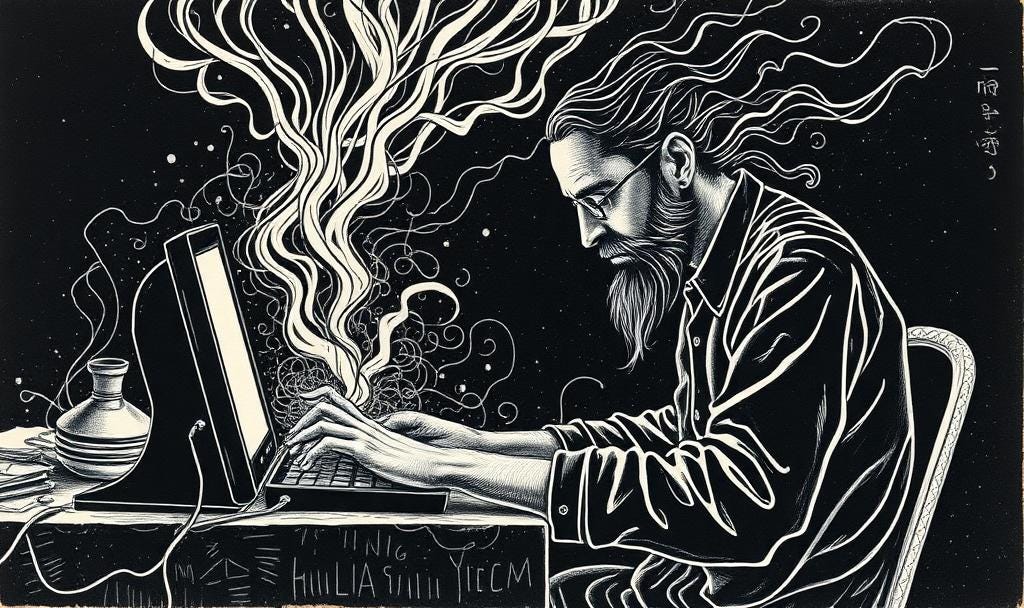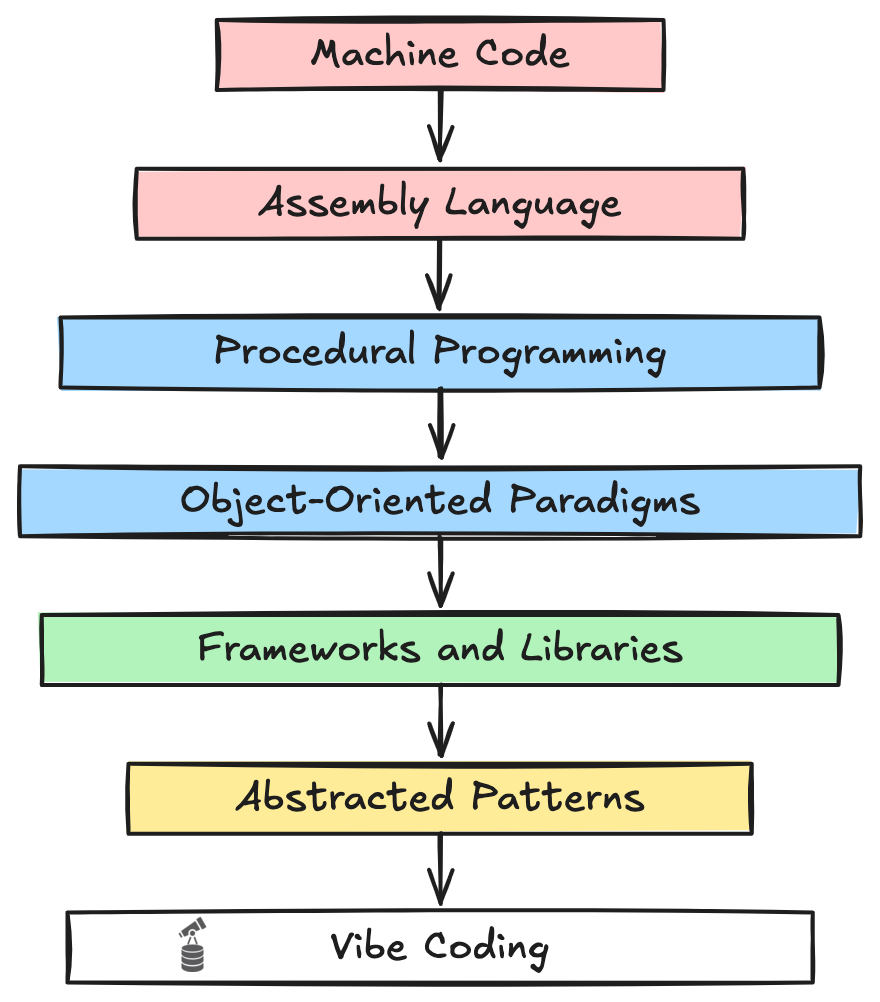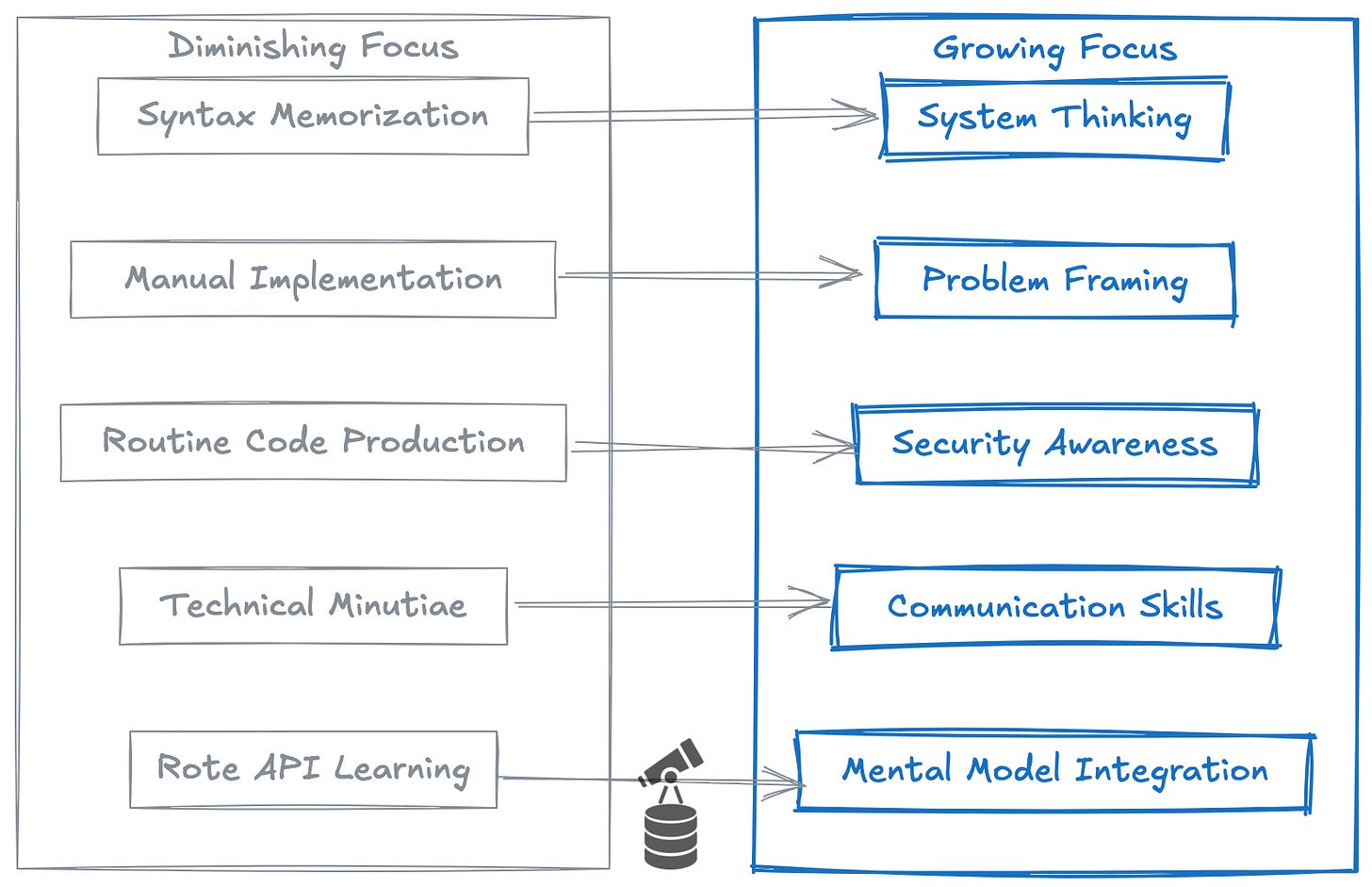The Vibe Coding Conundrum: Enslave AI Or Cultivate Human Understanding?
How AI coding assistants are turning developers into prompt engineers — and why understanding what's under the hood still matters.
The Seduction of Effortless Code
In the ever-accelerating world of software development, a revolutionary approach has emerged that promises to change how we build digital products forever. It’s called “vibe coding,” a term coined by former Tesla AI director and OpenAI co-founder Andrej Karpathy in February 2025. The concept is disarmingly simple yet profound: stop writing code altogether. Instead, describe what you want in natural language, and let AI generate everything for you.
As Karpathy himself put it, vibe coding is when you “fully give in to the vibes, embrace exponentials, and forget that the code even exists.” This approach embodies a carefree relationship with software development—one where you “just see stuff, say stuff, run stuff, and copy paste stuff, and it mostly works.”1
The promise is irresistible. Why spend years mastering programming languages, algorithms, and architectural patterns when you can simply explain your idea to an AI? Why debug tedious syntax errors when you can paste error messages into an AI prompt and receive instant fixes? The learning curve traditionally associated with software development suddenly vanishes, replaced by your ability to clearly articulate what you want.
The mainstream adoption has been staggering. According to Wikipedia, just weeks after Karpathy’s initial tweet, Y Combinator reported that 25% of startups in its Winter 2025 batch had codebases that were 95% AI-generated2. The Merriam-Webster Dictionary quickly added “vibe coding” to its “slang & trending” category just a month after the term’s creation. Major publications from The New York Times to The Guardian covered the phenomenon, all pondering the same question:
Is traditional coding becoming obsolete?
But as with any revolution, the initial euphoria often masks deeper complexities and unintended consequences lurking beneath the surface.
The real question isn’t whether vibe coding works - it clearly can produce functional software - but at what cost, and with what limitations?
A Dialectical Analysis
Let’s analyze this conundrum from different viewpoints so we gain a more mature understanding of the changing development landscape and how we as engineers fit into it.
Thesis: The Case for Vibe Coding
The shift from traditional coding to vibe coding represents more than just a change in tools; it’s birthing an entirely new species of developer. The archetypal software engineer - immersed in technical documentation, debugging complex integrations, and obsessing over performance optimizations - is being challenged by the vibe coder: someone who treats software development primarily as a communication exercise with AI. Their skill lies not in technical implementation but in articulation and vision.
The democratization argument is particularly compelling. Software has eaten the world, yet the ability to create software has remained concentrated in the hands of a technical elite. Vibe coding promises to distribute this power more broadly, enabling anyone with a clear vision to bring their ideas to life regardless of their technical background.
Research from GitHub shows that AI-assisted development can significantly boost productivity. One study found that developers completed tasks 55% faster when using GitHub Copilot. Furthermore, GitHub’s analysis revealed that on average, users accept nearly 30% of code suggestions from AI assistants and report increased productivity from these acceptances3.
Even for experienced developers, the efficiency gains can be substantial. Tasks that once took days can be completed in hours.
Boilerplate code, repetitive patterns, and common integrations can be delegated to AI, freeing human creativity to focus on novel problems and innovative solutions.
Antithesis: The Hidden Costs
Yet beneath the gleaming surface of vibe coding’s promise lies a darker reality that becomes apparent as systems mature and complexities emerge. The initial euphoria of “it mostly works” gives way to sobering challenges that reveal the true cost of abdicating understanding.
Perhaps the most dangerous assumption in vibe coding is that AI can fully comprehend the context of what it’s building. The reality is far more limited. Despite impressive capabilities, today’s AI models struggle with the complete picture of complex systems—especially as they evolve over time.
Security experts at Checkmarx highlight several critical risks with vibe coding, including “Unvetted AI-Generated Code” that could lead to vulnerabilities like SQL injections and insecure authentication mechanisms. They also warn about “Over-Permissioned AI Agents” that, if compromised, could unintentionally expose sensitive assets.4
A case documented by several tech publications involved a self-proclaimed “non-technical” entrepreneur who proudly announced building a SaaS product with “zero hand-written code.” Days later, they frantically posted about being “under attack” with bypassed subscriptions, maxed-out API keys, and corrupted databases.
This scenario perfectly illustrates what Simon Willison, a respected open-source developer and AI researcher, cautions about: “Vibe coding your way to a production codebase is clearly risky. Most of the work we do as software engineers involves evolving existing systems, where the quality and understandability of the underlying code is crucial.”5
This highlights the fundamental limitation of vibe coding: an AI might generate functional code for isolated features, but it lacks the holistic understanding of system interactions that develops through experience and education. Each new feature introduces complexity that compounds over time, creating a web of interdependencies too nuanced for current AI models to fully comprehend within their token limitations.
There’s a term in economics that perfectly captures the long-term risk of vibe coding:
sharecropping
In its traditional form, sharecropping involved farmers working land they didn't own or understand how to manage independently. They became permanently dependent on landowners, trapped in a cycle where they could never build equity or self-sufficiency.
Vibe coding creates a similar dynamic—digital sharecropping—where developers become permanently dependent on AI systems they don’t fully understand. Every new feature, every bug fix, every optimization requires returning to the AI, unable to make even simple changes independently. The codebase becomes a foreign territory, inhabited but not owned.
Research on technical debt supports this concern. According to Forrester (as reported by Tabnine), the unchecked use of agent-based coding tools could lead to a “technical debt tsunami over the next 2 years.” One study on GitHub Copilot found security vulnerabilities in 40% of analyzed code snippets6.
This dependency represents a new form of technical debt. Traditional technical debt involves engineering shortcuts that save time now but cost more later. Vibe coding debt is more insidious: it’s knowledge debt.
The interest isn’t paid in refactoring time but in permanent dependency—an ever-growing gap between what your software does and what you understand about how it works.
Synthesis: The Responsible Middle Path
Software development has always been a discipline built in layers. Like the geological strata of Earth’s crust, each generation of technology builds upon the foundations laid before it. Machine code gave way to assembly language, which evolved into procedural programming, then object-oriented paradigms, followed by frameworks and libraries that abstracted away common patterns.
Each layer of abstraction allowed developers to work at a higher level, focusing on business logic rather than low-level implementation details. Abstraction—hiding complexity behind simpler interfaces—has always been the engine of progress in software development.
Vibe coding represents the most radical abstraction yet: the complete removal of coding itself. But unlike previous abstractions, which built carefully upon the layers below, vibe coding attempts to bypass the entire stack, jumping directly from human intention to executing code. This raises a critical question: which layers of knowledge can we safely abstract away, and which remain essential?
Research in cognitive psychology and software engineering emphasizes the importance of mental models—internal representations of how systems work—in effective software development. As one study published in the Journal of Software Engineering explains, “Programmers’ mental models represent their knowledge and understanding of programs, programming concepts, and programming in general. They guide programmers’ work and influence their task performance.”7
For all the potential pitfalls of vibe coding, it would be a mistake to dismiss AI-assisted development entirely. Used correctly, AI can be the perfect coding partner—not a replacement for technical knowledge, but a force multiplier for it.
Consider the experienced developer who understands database normalization principles, REST API design patterns, and authentication best practices. When they use an AI coding assistant, they’re not abdicating responsibility for understanding; they’re delegating implementation. They know exactly what they want, why they want it, and how to verify it works correctly. The AI simply accelerates their workflow, handling boilerplate and repetitive tasks with superhuman efficiency.
So, which concepts must developers still internalize, even if they never write that code themselves?
Developers must cultivate systemic thinking: understanding how components interact, how data flows through applications, how security vulnerabilities emerge, and how performance bottlenecks form. These insights transcend specific programming languages or frameworks. They represent the geological bedrock upon which all software—regardless of how it’s created—must ultimately stand.
Here’s a map of what developer traditionally focused on and how vibe coding is changing it all…
The Human Core of Software Development
At its heart, it’s about solving human problems through logical systems—translating messy reality into structured solutions. AI coding tools change how we implement these solutions, but they don’t change the fundamental nature of the challenge.
Software development has always been a deeply human activity, despite its technical nature, but now the focus moves from “how to code” to “how to think about code.”
As the lines between prompt engineering and software engineering continue to blur, the sweet spot emerges: using AI to implement what we understand rather than to avoid understanding altogether. In that balanced approach lies the path to software that is not only functional but robust, secure, and truly owned by its creators.
The future of development belongs not to those who surrender understanding in the name of convenience, but to those who harness AI’s capabilities while preserving the human insight, creativity, and responsibility that make software development not just a technical discipline but a craft worthy of mastery.
How are you using AI in your development workflow? Are you finding the sweet spot between delegation and understanding? Share your experiences in the comments below.
If you enjoyed this exploration of AI’s impact on software development, consider subscribing to Stackgazer for more thoughtful analysis at the intersection of technology, philosophy, and human experience.
https://x.com/karpathy/status/1886192184808149383








I wish I’d read yours before I wrote mine 🙏 https://infophilia.substack.com/p/vibe-coding